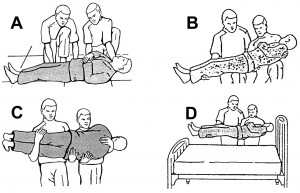Situations may arise which require a patient to be lifted from the floor to a bed or wheeled litter. For this procedure, perhaps two bearers should be sufficient to lift a lightweight patient but three or more bearers are necessary to lift a heavy patient.
The signals or commands should be given by the bearer lifting the patient’s head and shoulders. The following procedures are appropriate.
a. Place the bed or stretcher to receive a patient lifted from the floor at the far side of the patient and parallel to him.
Lock the wheels of the bed or stretcher. All bearers kneel on the knee nearest the patient’s feet. Each bearer slides his arms under the patient at a space interval, which allows the bearer’s elbows to be held close to his body, while supporting the patient’s shoulders, back, hips, and thighs (figure 2-23A).
b. At the command, all lift in unison, shifting weight backward, and carrying the patient to a support position on their braced thighs (the thigh toward the patient’s head) (figure 2-23B).
c. Continuing in the kneeling position and at the command, all lift and turn the patient inward their chest.
Now, with back straight, all rise to standing position (figure 2-23C).
NOTE: This is a key maneuver for proper weight distribution. Attempting to rise to a standing position while supporting the patient’s weight on the outstretched forearms will cause a severe strain.
d. To lower the patient to a bed placed parallel, all step forward to the side of the bed.
Flexing the knees, shifting the weight to the front, and keeping the back straight, lower the patient gently to the bed (figure 2-23D).

